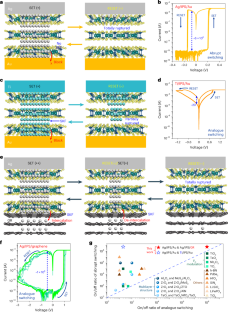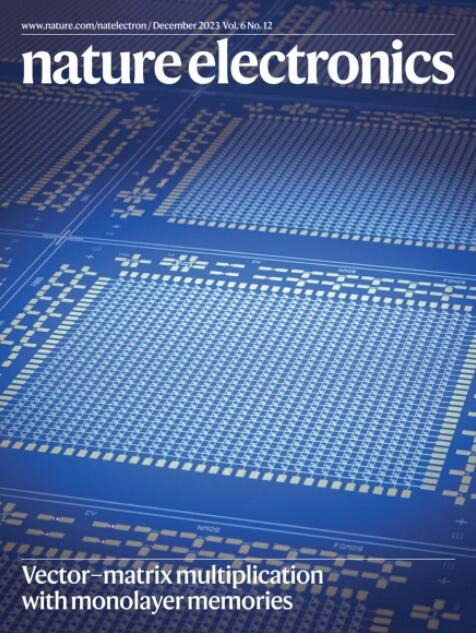利用范德华金属阴极实现模拟开关和高开/关比率的薄膜晶体管
IF 40.9
1区 工程技术
Q1 ENGINEERING, ELECTRICAL & ELECTRONIC
引用次数: 0
摘要
基于忆阻器的神经形态计算有助于满足人工智能等数据密集型计算应用日益增长的需求。具有多种电导状态的模拟忆阻器在高效神经形态计算中特别有用,但它们的权重映射能力通常受到小开关比的限制。在这里,我们展示了使用二维范德华金属材料(石墨烯或二碲化铂)作为阴极,可以制造出具有模拟电阻开关和大导通/关断比的忆阻器。忆阻器使用银作为顶部阳极,硫化铟磷作为开关介质。以前的方法主要是通过改变电阻开关层或阳极来调制离子运动,这可能会降低开/关比率。相比之下,我们的方法依赖于范德瓦耳斯阴极,它允许银离子插层/去插层,从而形成一个高扩散屏障来调节离子运动。这种策略可以实现开关比高达 108 的模拟电阻开关、超过 8 位的电导状态和阿托焦耳级的功耗。我们利用其模拟特性,对具有高识别精度的卷积神经网络进行了芯片级仿真。本文章由计算机程序翻译,如有差异,请以英文原文为准。


Memristors with analogue switching and high on/off ratios using a van der Waals metallic cathode
Neuromorphic computing based on memristors could help meet the growing demand for data-intensive computing applications such as artificial intelligence. Analogue memristors with multiple conductance states are of particular use in high-efficiency neuromorphic computing, but their weight mapping capabilities are typically limited by small on/off ratios. Here we show that memristors with analogue resistive switching and large on/off ratios can be created using two-dimensional van der Waals metallic materials (graphene or platinum ditelluride) as the cathodes. The memristors use silver as the top anode and indium phosphorus sulfide as the switching medium. Previous approaches have focused on modulating ion motion using changes to the resistive switching layer or anode, which can lower the on/off ratios. In contrast, our approach relies on the van der Waals cathode, which allows silver ion intercalation/de-intercalation, creating a high diffusion barrier to modulate ion motion. The strategy can achieve analogue resistive switching with an on/off ratio up to 108, over 8-bit conductance states and attojoule-level power consumption. We use the analogue properties to perform the chip-level simulation of a convolutional neural network that offers high recognition accuracy. Memristors with on/off ratios up to 108 and analogue resistive switching can be created using the intercalation/de-intercalation of silver ions in a two-dimensional metallic electrode to modulate ion migration.
求助全文
通过发布文献求助,成功后即可免费获取论文全文。
去求助
来源期刊

Nature Electronics
Engineering-Electrical and Electronic Engineering
CiteScore
47.50
自引率
2.30%
发文量
159
期刊介绍:
Nature Electronics is a comprehensive journal that publishes both fundamental and applied research in the field of electronics. It encompasses a wide range of topics, including the study of new phenomena and devices, the design and construction of electronic circuits, and the practical applications of electronics. In addition, the journal explores the commercial and industrial aspects of electronics research.
The primary focus of Nature Electronics is on the development of technology and its potential impact on society. The journal incorporates the contributions of scientists, engineers, and industry professionals, offering a platform for their research findings. Moreover, Nature Electronics provides insightful commentary, thorough reviews, and analysis of the key issues that shape the field, as well as the technologies that are reshaping society.
Like all journals within the prestigious Nature brand, Nature Electronics upholds the highest standards of quality. It maintains a dedicated team of professional editors and follows a fair and rigorous peer-review process. The journal also ensures impeccable copy-editing and production, enabling swift publication. Additionally, Nature Electronics prides itself on its editorial independence, ensuring unbiased and impartial reporting.
In summary, Nature Electronics is a leading journal that publishes cutting-edge research in electronics. With its multidisciplinary approach and commitment to excellence, the journal serves as a valuable resource for scientists, engineers, and industry professionals seeking to stay at the forefront of advancements in the field.
 求助内容:
求助内容: 应助结果提醒方式:
应助结果提醒方式:


